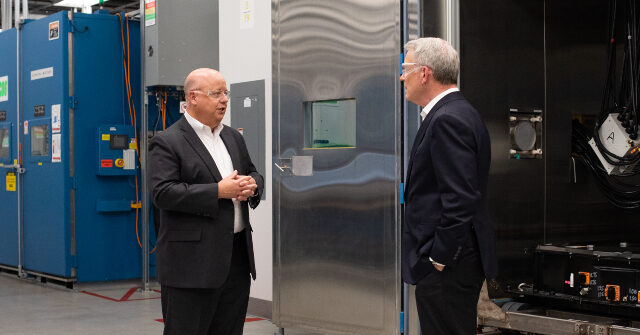General Motors (GM) said this week it will upgrade its facilities across the United States to boost its electric battery production and ensure America’s ability to lead in electric vehicle battery manufacturing.
General Motors and LG Energy Solution announced this week that they would upgrade their Ultium Cells Spring Hill, Tennessee, battery cell manufacturing facility to upgrade production of low-cost lithium iron phosphate (LFP) battery cells. This upgrade builds upon a $2.3 billion investment in 2021. Ultium Cells is a joint venture between the two companies to provide battery cell capacity support for GM’s North American electric vehicle capacity as well as supporting GM’s plans to supply other automotive companies and other industries including rail, aerospace, heavy trucking, and more.
The conversion of battery cell lines at Spring Hill to produce LFP cells will begin later in 2025, with commercial production expected by late 2027.
“At GM, we’re innovating battery technology to deliver the best mix of range, performance, and affordability to our EV customers,” Kurt Kelty, vice president of batteries, propulsion, and sustainability at GM, said in a statement.
“This upgrade at Spring Hill will enable us to scale production of lower-cost LFP cell technologies in the U.S., complementing our high-nickel and future lithium manganese rich solutions and further diversifying our growing EV portfolio,” he added.
LFP is viewed as a low-cost battery option, according to Mark Reuss, president of GM:
In addition to today’s nickel cobalt manganese aluminum (NCMA) pouch cells, the Ultium Cells plant will produce battery cells using lithium iron phosphate (LFP) chemistry. LFP was an American breakthrough that’s grown in popularity as a low-cost battery solution worldwide. I’m proud that we’re bringing its benefits – and associated jobs – back to America. Work on the LFP battery cell lines at Spring Hill will start soon, with full commercial production targeted for late 2027.
With Spring Hill established as the home for LFP, the next step will be finalizing a home for lithium manganese rich (LMR) chemistry. As we recently announced, GM plans to be the first company to produce LMR prismatic battery cells at commercial scale. This advancement is key to delivering the best mix of range, performance, and affordability for our EV customers.
“The upgrade reflects the continued strength of our partnership with General Motors and our shared commitment to advancing EV battery innovation,” Wonjoon Suh, executive VP and head of the Advanced Automative Battery division at LG Energy Solution, said in a statement. “We will bring our extensive experience and expertise in U.S. manufacturing to the joint venture facility, further accelerating our efforts to deliver new chemistries and form factors that effectively capture the unmet needs in the EV market.”
The Ultium Cells facility in Spring Hill employs roughly 1,300 people and aims to increase U.S. battery innovation, manufacturing, and consumer choice in the electric vehicle market.
Kee Eun, president and CEO of Ultium Cells, said:
We are grateful for the continued partnership and support we’ve received from the State of Tennessee as we continue to advance our lead in EV battery cell manufacturing. This investment expands our capabilities beyond a single battery cell chemistry, allowing us to produce new chemistries alongside our existing cells. Expanding our product portfolio ensures Ultium Cells will remain at the forefront of battery cell innovation and sustain our commitment to be a stable, long-term employer for the communities we serve.
This June in Warren, Michigan, General Motors placed the final steel beam for its Ancker-Johnson Battery Cell Development Center on its almost seven-decades-old Global Technical Center campus outside Detroit. Coupled with its Wallace Battery Cell Innovation Center, the company has invested $900 million to boost America’s competitive edge in the global race for battery leadership.
GM said that its investments aim to build a more resilient, American-based electric vehicle material supply chain, including U.S.-sourced lithium and magnets.
“Our commitment to modern facilities and cutting-edge equipment far exceeds the investment of any U.S. automaker,” GM wrote in a press release.
Sean Moran is a policy reporter for Breitbart News. Follow him on X @SeanMoran3.
Read the full article here


